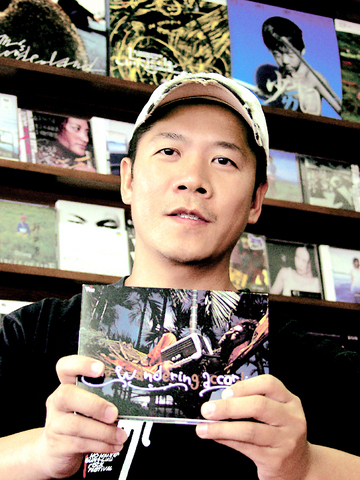From his suburban home / studio in Chongho, Taipei County, Xiao Qing-yang (蕭青陽) has taken his unique album-cover design style where no other Taiwanese has gone before: the Grammys.
Last month, staff from Wind Records, which releases mostly Taiwanese and Chinese folk and New Age music in Asia and the US, called Xiao with news that he had been nominated for a Grammy in the Best Package Award category for his cover art on the label's instrumental album The Wandering Accordion (飄浮手風琴). It might not be the highest-profile category, but being a part of the Grammys is nonetheless cause for considerable celebration back home.

Xiao's not very concerned about winning the award. "Just getting nominated is already a big deal for me," he said during a recent visit to his studio.

PHOTOS COURTESY OF SHOUT STUDIO
"Now the question is whether we'll get to go to the ceremony [in Los Angeles next month]. It'll be a nice excuse to take the family on vacation," said the father of two.
Xiao's competition in the category will be album covers for The Shins, Ani DiFranco, the Beastie Boys and Wilco, all of which share a similar compositional minimalism that diverges from the bright explosions of color that describe Xiao's tropical-themed design on The Wandering Accordion. If the judge panel places a premium on richness of color, Xiao would appear to be a shoo-in for the award.
Getting noticed abroad has taken Xiao almost 20 years, but, in Taiwan, his cover art and graphic design is ubiquitous.
His work for Wind Records on four albums so far shows his penchant for unorthodox package formats, with The Wandering Accordion released in an elongated rectangular case, the cover of which features the album's musician Wang Ying-meng (王雁盟) lazing away on a hammock slung between two betel nut trees on the beach in Taitung. The sun filters down through the luxuriant fronds, illuminating bright greens, blues and the musician's ochre pants in an image that, at a glance, encapsulates the carefree spirit of the instrumental album.
He wanted to use a theme that was instantly recognizable as Taiwan to go with the music. "So, in the end, we chose the betel-nut tree stand," Xiao said. He thought of going to Okinawa or Hawaii just to get a nice background and blue sky, "but then we thought, why not just go to Taitung instead."
Ironically, Xiao is probably best known locally for his designs for all of Taiwan Colors Music's 32 albums, the CDs for which are sold in large, 25cm-by-25cm format packages. The eye-catching designs are widely credited with helping to establish the five-year-old label's distinctive style within Taiwanese independent music, but are not eligible for Grammy nominations because the label does not yet release albums in the US.
Other works for which Xiao can take credit are the designs used in the print material, T-shirt design, promotional flags and stage design for the Ho-Hai-Yan Rock Festival held every summer for the past five years, as well as a long list of covers for Rock Records, including landmark albums by pop stars Chang Chen-yue (張震嶽) and Faith Yang (楊乃文).
"The Ho-Hai-Yan flags have been so popular, there has actually been a problem with theft," Xiao said.
Sitting in his studio, surrounded by enlarged, framed versions of his award-winning designs that turn the space into a cross between storage facility and gallery, Xiao is a remarkably self-effacing character. His achievements over the years in design, he says, are the fruit of extensive cooperation with record labels, some of which can be exceptionally nitpicky when it comes to promoting their stars.
"Design is essentially a commercial undertaking, so I have to follow the companies' orders. And some labels are really quite conservative when it comes to design, which can be a drag," he said.
Wind Records and Taiwan Colors Music, by contrast, gave Xiao free rein over the designs for the covers they've commissioned, which allowed him to experiment more liberally and develop the aesthetic that has emerged in the past several years that is so unmistakably his own.
"I sit down with a specific feeling in mind before I create and the design just builds itself layer after layer, starting normally with a photo that I particularly like," he said.
Having hit stride in his design career with the Grammy nomination, he said he now hopes to shift his focus toward painting as the starting point for his designs.
"It used to be a struggle to do this type of design in Taiwan. But now I feel alright with it as a job," he said. "Now I really like to set up a huge canvas, like as tall as me, and start that way, working really slowly just to see what comes out at the end."

June 9 to June 15 A photo of two men riding trendy high-wheel Penny-Farthing bicycles past a Qing Dynasty gate aptly captures the essence of Taipei in 1897 — a newly colonized city on the cusp of great change. The Japanese began making significant modifications to the cityscape in 1899, tearing down Qing-era structures, widening boulevards and installing Western-style infrastructure and buildings. The photographer, Minosuke Imamura, only spent a year in Taiwan as a cartographer for the governor-general’s office, but he left behind a treasure trove of 130 images showing life at the onset of Japanese rule, spanning July 1897 to

One of the most important gripes that Taiwanese have about the Democratic Progressive Party (DPP) is that it has failed to deliver concretely on higher wages, housing prices and other bread-and-butter issues. The parallel complaint is that the DPP cares only about glamor issues, such as removing markers of Chinese Nationalist Party (KMT) colonialism by renaming them, or what the KMT codes as “de-Sinification.” Once again, as a critical election looms, the DPP is presenting evidence for that charge. The KMT was quick to jump on the recent proposal of the Ministry of the Interior (MOI) to rename roads that symbolize

On the evening of June 1, Control Yuan Secretary-General Lee Chun-yi (李俊俋) apologized and resigned in disgrace. His crime was instructing his driver to use a Control Yuan vehicle to transport his dog to a pet grooming salon. The Control Yuan is the government branch that investigates, audits and impeaches government officials for, among other things, misuse of government funds, so his misuse of a government vehicle was highly inappropriate. If this story were told to anyone living in the golden era of swaggering gangsters, flashy nouveau riche businessmen, and corrupt “black gold” politics of the 1980s and 1990s, they would have laughed.

It was just before 6am on a sunny November morning and I could hardly contain my excitement as I arrived at the wharf where I would catch the boat to one of Penghu’s most difficult-to-access islands, a trip that had been on my list for nearly a decade. Little did I know, my dream would soon be crushed. Unsure about which boat was heading to Huayu (花嶼), I found someone who appeared to be a local and asked if this was the right place to wait. “Oh, the boat to Huayu’s been canceled today,” she told me. I couldn’t believe my ears. Surely,